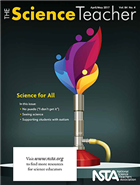Science 2.0: Communicating Science Creatively
By sstuckey
Posted on 2017-04-18
We’ve been covering the International Society for Technology in Education (ISTE) standards in every issue since September. This month, we examine the final standard, called Creative Communicator, which requires students to communicate effectively and creatively express themselves (ISTE 2016). The science curriculum provides opportunities for students to express their understanding of concepts. Science involves more than collecting data and crunching numbers. Scientists must also be able to explain their work. We need to create persuasive arguments that support our conclusions.
Meeting the performance indicators
The performance indicators of this standard state that students need to choose, create, remix, communicate, and publish. For teachers, facilitating this type of work calls for a change in instructional design. The activities in your classroom must require students to communicate their understanding of a lab and what they’ve learned from it.
Students need to be able to choose the appropriate platform and tool for their presentations. For example, a poster on a trifold board could be used instead of a written report to present scientific work. When technology is brought into play, students have a much wider choice of media when presenting their work.
We ask our students to communicate their results of a lab report in three steps (explain what you did, explain what you found out, and describe how you found out) to summarize their findings. This summary can take place in virtually any medium. When students were learning to use digital graphic organizers, we would allow them to use a flow chart for their conclusions. They can easily paste pictures of lab setups, graphs, and other media into many tools (e.g., Inspiration, LucidChart, Poplet, MindMaps). Some students may make an infographic, while others may use Google Slides, write a song, or even compose a haiku.
Some students concluded a lab on the conservation of momentum with PowToon, an animation tool that creates a video with music. The lab asked students to collide carts and use motion sensors to record the data. Students used tools in Powtoon to explain what they did and then used other tools with imported images of their graphs to explain what they found. Overall, it was a creative, effective effort at completing the three components of the conclusion.
Additionally, this standard asks students to create original work or remix the work of others. We hang signs in our classroom that say “UCC,” which stands for “user-created content.” Almost every laptop, tablet, or phone has a camera, offering opportunities for students to take their own photos of equipment setup, written work, or scientific phenomena. Students can also use online simulations and their own videos to remix and communicate their work.
Finally, this standard requires students to publish their customized work. Online tools make publishing easy. Teachers should consider using a website that allows students to keep a portfolio of their best work. A web tool that allows students to edit pages (Google Sites or Wikispaces) will help accomplish this task. Students can link their products and use this to reflect on the tools they have learned and the methods they have used for communicating.
Conclusion
Becoming a creative communicator requires students to learn a variety of tools and develop the ability to evaluate the choice of the right tool for the task at hand. Students will learn how to become creative by using different tools and incorporating media into their work. This standard allows students to present their scientific work in a way that demonstrates their understanding both visually and verbally.
Ben Smith (ben@edtechinnovators.com) is an educational technology program specialist, and Jared Mader (jared@edtechinnovators.com) is the director of educational technology, for the Lincoln Intermediate Unit in New Oxford, Pennsylvania. They conduct teacher workshops on technology in the classroom nationwide.
Reference
International Society for Technology in Education (ISTE). 2016. The 2016 ISTE standards for students. Arlington, VA: ISTE. http://bit.ly/ISTE-standards.
Editor’s Note
This article was originally published in the April 2017 issue of The
Science Teacher journal from the National Science Teachers Association (NSTA).
Get Involved With NSTA!
Join NSTA today and receive The Science Teacher,
the peer-reviewed journal just for high school teachers; to write for the journal, see our Author Guidelines, Call for Papers, and annotated sample manuscript; connect on the high school level science teaching list (members can sign up on the list server); or consider joining your peers at future NSTA conferences.
Disclaimer: The views expressed in this blog post are those of the author(s) and do not necessarily reflect the official position of the National Science Teaching Association (NSTA).


